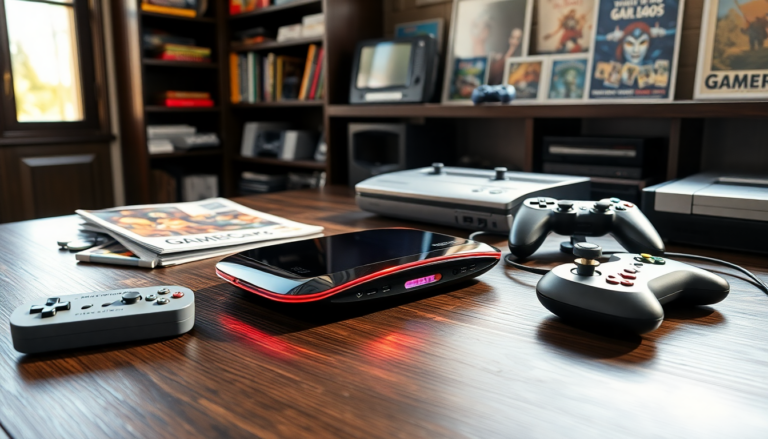Argomenti trattati
The retro gaming landscape is undergoing an exciting transformation, largely thanks to cutting-edge technologies that are making nostalgic gaming more accessible than ever. Take the recent launch of the GamerCard, a handheld device crafted by Grant Sinclair, for example. This innovative gadget isn’t just a throwback to the good old days; it’s also a glimpse into the future of gaming, appealing to both seasoned players and newcomers alike. Isn’t it fascinating how technology can bridge generations of gamers?
The Revival of Retro Gaming
In recent years, the retro gaming sector has seen a major comeback, fueled by a growing desire for devices that evoke nostalgia while also providing modern functionality. According to industry reports, retro gaming is gaining serious traction, with a noticeable uptick in sales for both hardware and software. Could this be a sign of a broader cultural movement? It seems that more people are beginning to appreciate the simplicity and charm of classic games.
Avid gamers today have a plethora of options, ranging from physical handheld consoles to sophisticated software emulators that replicate the classic gaming experience on contemporary devices. Enter the GamerCard—its ultra-portable design is not only convenient but also a testament to shifting consumer preferences, emphasizing portability without compromising the gaming experience. What could be better than gaming on-the-go?
Innovative Features and User Experience
Measuring roughly the size of a standard gift card, the GamerCard is powered by a Raspberry Pi and features a vibrant 4-inch IPS screen with a pixel density of 254 PPI, delivering a clear and immersive gaming experience. Beneath the screen, two circular pads equipped with tactile buttons enhance gameplay, providing a responsive interface that users will appreciate. Preloaded with a selection of high-energy arcade games, the device is tailored for those looking for immediate gaming fun without the hassle of complicated setups.
But that’s not all. The GamerCard’s custom home launcher simplifies navigation with large, easy-to-read icons for games and emulators. It even supports various coding languages, including MicroPython and C++, enabling users to dive into game development while enjoying their favorite titles. How cool is that? This dual functionality broadens the device’s appeal, catering not only to gamers but also to budding developers.
To sweeten the deal, the GamerCard includes two indie games, Bloo Kid 2 and AstroBlaze DX, both optimized to leverage its unique display aspect ratio. With their engaging pixel-art style, these games resonate perfectly with the nostalgic themes that retro gaming enthusiasts hold dear.
Value Proposition and Market Positioning
Priced at £125 (around $170), the GamerCard carves out a unique niche in the portable gaming market. While it boasts innovative features and a compact design, potential buyers might wonder about its value compared to existing alternatives. For instance, the Retroid Pocket 4 Pro is available at a lower price, as are various Anbernic devices that deliver solid performance without stretching your budget.
Furthermore, the GamerCard’s design philosophy—favoring a stacked PCB configuration over traditional housing—gives it a distinct aesthetic appeal. Yet, this uniqueness raises questions about practicality versus creativity. Is the novelty worth the price? Like any investment, consumers must weigh the benefits of owning a device that prioritizes innovation against the possibility of finding more budget-friendly options that offer similar gaming experiences.
Ultimately, the GamerCard stands as a shining example of creativity and innovation within the retro gaming market. It invites consumers to embrace nostalgia while carefully considering the practical implications of their purchases. For those who cherish retro gaming, this device could be a delightful addition to their collection, even with a price tag that reflects its unique design and capabilities.
Future Trends in Portable Gaming
As the retro gaming market continues to evolve, we can expect to see further innovations in portable gaming devices. The success of products like the GamerCard highlights a growing consumer appetite for compact solutions that enhance the gaming experience while honoring the classics. Future developments may focus on improving functionality, such as battery life and performance, and exploring new ways to blend modern technology with nostalgic gameplay. What exciting advancements lie ahead?
In conclusion, the rise of ultra-portable gaming devices signals a promising future for retro gaming enthusiasts. As technology advances, we’re likely to see unique gaming experiences that combine the charm of the past with the convenience of the present, captivating more players to this beloved genre. The GamerCard is leading the charge, showing us just how innovation can breathe new life into cherished classics.

